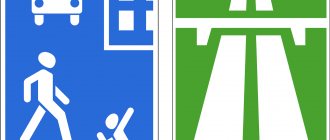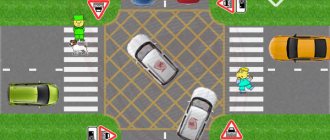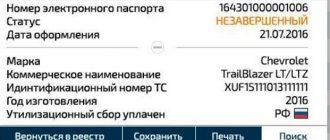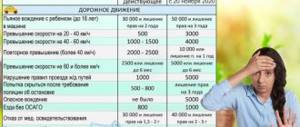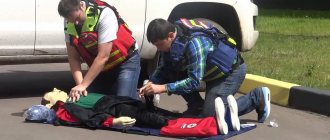Failure to comply with the speed limit on the road is an administrative violation and is subject to fines. Every driver must know what the permissible speed limit is in Russia in 2020 in order to protect the health and lives of others, and themselves, from problems with representatives of the law. Drivers are advised to adhere to certain speed limits on various sections of the roadway, not to ignore the permissible speed limit on each of them, and to strictly adhere to current traffic rules.
Speed limits in Russia
Speeding in the city and beyond is an administrative offense. The violator may be subject to either a fine or a more serious punishment. In accordance with paragraphs 10.2-10.4 of the traffic rules, the maximum speed in the city or other populated areas is 60 km/h for any vehicle. When towing a motor vehicle, the speed limit is 50 km/h. When traveling in a residential, bicycle or yard zone, the permissible speed is 20 kilometers per hour.
You can travel on the motorway at the following speeds:
- Category C trucks, cars with trailers and buses – 90 km/h;
- motorcycles, cars and trucks of category B – 110 km/h;
- for buses during the organized transportation of children and trucks that transport people in the back - 60 km/h;
- when towing a mechanical vehicle – 50 km/h.
When driving outside the city, but not on the highway, you are allowed to drive at the following speed:
- for cars, motorcycles, category B trucks, buses with a small number of seats and intercity buses – 90 km/h;
- passenger cars with trailers, category C trucks and other buses – 70 km/h;
- trucks that carry people in the back and buses during the organized transportation of children - 60 km/h;
- when towing a mechanical vehicle – 50 km/h.
In addition, there may be a speed limit sign on the road. In such places you can drive at the speed indicated on the sign.
Please note that the maximum speed is 130 km/h (in accordance with paragraph 10.3 of the traffic rules). Signs marked 140-150 km/h are fake.
Current position and need for changes in speed limits
Experts support the decision to lower the speed limit. You can take into account the error of the car's speedometer, as well as a number of other conditions that justify a slight excess. But speaking of an increase of 20 kilometers per hour, we are already talking about a deliberate violation.
In addition to changes in legislation, it is also planned to check the condition of roads. This also applies to the installation of signs that fraudulently place the vehicle owner in an uncomfortable position. Thus, in addition to changes in norms, an actual verification of the situation is also necessary. The 20-kilometer limit justifies shortcomings in the legislation and, to some extent, protects drivers from excessive fines. Therefore, before changing these norms, consideration of other rules and procedures will be required.
In addition to all of the above, the lives of pedestrians also depend on the movement of the car. Repeatedly, ordinary passers-by suffered due to the driver’s negligence. For this reason, it is worth noting that reducing the permissible excess will also affect this issue. We should not ignore the fact that not only citizens who were driving suffer as a result of road accidents. Unfortunately, such incidents can end very tragically for ordinary passers-by who happen to be nearby.
What is the fine for speeding in 2021?
The government planned to significantly increase speeding fines in 2021. Thus, it was assumed that for driving 20-40 km/h over the speed limit, instead of 500 rubles, you would have to pay 3,000 rubles. But this idea was later abandoned, and the increase in fines for traveling at high speeds was rejected. In accordance with Article 12.9 of the Code of Administrative Violations, the minimum fine in 2021 is still 500 rubles, and the maximum fine for speeding is 5,000 rubles.
You can view all the sanctions in the table of fines for speeding:
| Over speed | Punishment for speeding (if recorded by the traffic police) | Punishment for speeding (if recorded on camera) |
| At 20-40 km/h | 500 rubles | 500 rubles |
| At 40-60 km/h | 1,000-1,500 rubles | 1000 rubles |
| At 60-80 km/h | 2,000-2,500 rubles or deprivation of rights for 4-6 months | 2,500 rubles |
| More than 80 km/h | 5,000 rubles or deprivation of rights for 4-6 months | 5,000 rubles |
It is worth noting that traffic police fines for speeding, issued when a violation is recorded by a camera, will not deprive a motorist of his license.
Punishment for repeat violations
If the speed limit is repeated, more stringent measures will be applied: either the fine will be increased several times, or the driver will be deprived of his license for 6-12 months.
The amount of the fine for repeated speeding can be found in the table:
| Over speed | Fine for repeated violation of the speed limit (issued by the traffic police) | Fine for repeated speed violation (recorded by camera) |
| At 20-40 km/h | 500 rubles | 500 rubles |
| At 40-60 km/h | 2,000 – 2,500 rubles | 2,000 rubles |
| At 60-80 km/h | Deprivation of rights for 1 year | 5,000 rubles |
| More than 80 km/h | Deprivation of rights for 1 year | 5,000 rubles |
Please note that a repeated fine for excess is considered a fine received more than 3 times within 1 year.
For what speeding is your license revoked?
Drivers who drive at a speed 60 km/h higher than the speed limit may be deprived of their license for speeding. For the first time, traffic police officers may revoke your license for speeding for 4-6 months. In case of repeated violation, the driver's license will be revoked for up to 1 year.
Fighting corruption or preventing new road accidents?
The first deputy chairman of the State Duma's authorized committee on constitutional legislation and state building, Vyacheslav Lysakov, who is also the leader of the Automobile Russia party, submitted for consideration his own version of solving the acute problem with the speed limit.
Lysakov proposes to reduce the speed limit for transport in cities and towns from today’s 60 km/h to 50 km/h. But, still, leave the permissible speed limit at 20 km/h. According to him, the result will be the same picture that the government is striving for - cars will drive no higher than 70 km/h within cities.
Such sophistications are necessary, the parliamentarian is sure, since the possible abolition of the existing limit can cause a resonance in society - drivers may see in such an innovation an attempt to rip off as much money as possible from them.
“We increased this limit from 10 to 20 km/h for certain reasons: due to the preparation of a point system, the fight against corruption on the roads. And I never proposed to cancel this innovation and now I oppose it, because all the conditions have been preserved. If we now begin to redraw the Code of Administrative Offenses again, the number of violators will increase sharply and the level of corruption will increase,” Lysakov noted.
At the same time, it is clear to everyone that reducing speed in cities will not provide a 100% solution to the problem. First of all, data on the increased number of collisions with pedestrians is associated with an increase in the number of vehicles.
The statistics are also affected by the unsatisfactory training of the drivers themselves, and the quality of the equipment at pedestrian crossings is in poor condition. The dispassionate statistics are also influenced by the carelessness of pedestrians themselves, who can afford to cross the road with headphones on or look at their mobile phones at this moment.
Pedestrians have completely forgotten about the rules of the road, according to which, before crossing the road, you need to wait for the green light of the traffic light and look both ways. Pedestrians are lulled into a false sense of security. But another fact cannot be ignored: even at a speed not exceeding 50 km/h, the driver may simply not have time to react, and the car may not have time to brake.
It is not clear at the moment which option for changing the speed limit on the roads will be adopted. But the fact that innovations are coming that many will not like is an indisputable fact.
Video about the culture of behavior on the roads and changes in traffic rules
Proposals to amend the traffic rules on speed limits on roads
Representatives of the Automobile Russia party have their own point of view on the emerging problem. Activists propose to shift the emphasis and pay attention to the maximum permissible speed of movement in populated areas. Therefore it is proposed:
- Reduce the rate of permissible movement within populated areas to 50 km/h;
- Leave the permissible limit unchanged - 20 km/h.
Don't miss: Will there be an increase in wages for public sector employees in Russia?
Balancing the two directions will bring two positive effects at once:
- reducing the speed of cars driving along city arteries, now law-abiding drivers will not allow themselves to cross the critical mark - 70 km/h;
- A shift in emphasis will help muffle possible public outcry and not provoke a surge in corruption.
Representatives of Automobile Russia issued a reminder that the non-punishable limit was increased in the fall of 2013 for a reason. The measure was taken at the stage of preparing a points system to combat corruption on the roads, and carries its own meaning.
This is why “Automobile Russia” does not advocate the abolition of permissible speeding, but is trying to look for a competent alternative.
Whereas another intervention with changes to the norms of the Code of Administrative Offenses may provoke an increase in violations and create preconditions for aggravating the situation with corruption.
Of course, changing the order of traffic around the city will solve only part of the problems. This is just one of the levers for manipulating discipline. Reducing the total number of road accidents is possible through:
- comprehensive solution to the problem;
- improving the level of behavior on the road for all road users.
A number of experts attribute the increase in the number of collisions with pedestrians to the rapid increase in the number of cars among the population and the increased number of drivers with a low level of qualifications.
Stabilization of the situation requires reforms in the provision of educational services leading to obtaining driving licenses.
Along with these measures, it is necessary to pay attention to how the areas specially designed for pedestrian crossings are equipped. The appearance of a significant part of pedestrian crossings leaves much to be desired.
Increasing the literacy and responsibility of pedestrians should be called a mandatory measure. Pedestrians are often distracted by their mobile phone or tablet.
They are completely lazy to look around, and crossing the road without removing the headphones from their ears is the norm of everyday life. Whereas in reality this is a gross violation of road rules.
Of course, reducing the speed limit to 50 is a significant step towards ensuring safety in the city. But we should not forget that the car is an object of increased danger and requires constant concentration from the driver. In any case, there is a possibility of not being able to brake in time.
One way or another, the topic of optimization in the motor transport environment in one form or another remains openly discussed. It is still unknown which option will be adopted by the Government of the Russian Federation or approved by the State Duma. But, of course, the time for change has come!
How to check for a fine
Fines for speeding in Russia can be checked:
- on the State Services portal;
- on the official website of the traffic police.
The driver can also receive the decision by mail.
To find out the current fines for speeding on one of the portals, you must enter your driver's license number, car number or decree number, if you have one.
Please note that in order to check for fines on State Services, you need a verified account on the portal.
How to pay fines
There are several ways to pay a fine for speeding:
- at the cash desk of any bank according to the details specified in the resolution;
- in terminals where it is possible to pay fines;
- on the State Services portal;
- on the official website of the traffic police.
The fine must be repaid within 60 days from the date of receipt.
If financial difficulties arise, you can apply for a deferment of 30 days or an installment plan of three months. To do this, it is necessary to provide to the traffic police, which issued the resolution, documents that confirm the difficult financial situation (for example, a certificate of registration at the labor exchange). It is worth considering that a deferment or installment plan is provided if traffic police officers consider the circumstances to be significant.
Please note that if you pay a fine through State Services in the first 20 days from the date of its imposition, you can receive a 20% discount. But only if:
- a fine for speeding is not repeated;
- the driver was not intoxicated;
- when committing the offense, no harm was caused to the health of other people.
If you do not pay the fine on time, the case will be referred to the bailiffs for enforcement. Liability for failure to pay a speeding fine may be as follows:
- a ban on using the car until the fine is paid;
- writing off funds from the violator’s account in the amount of the debt;
- seizure of property belonging to the driver.
In addition to forced collection of debt by bailiffs, the court also imposes administrative punishment. As a rule, the violator may be assigned:
- compulsory work for a period of 50 hours;
- doubling the amount of debt;
- arrest.
Permissible speed in the city
The speed limit varies depending on the type of vehicle and the type of roads. As a general rule, in city conditions, vehicles should move at a speed not exceeding 60 km/h. When towing, the maximum speed cannot exceed 50 km/h. City limits begin after the signs:
- a white rectangle in a black frame inside which the name of the locality is written in black letters
- a white rectangle in a black frame inside which a settlement is depicted in black
In residential areas marked with appropriate signs, the maximum permissible speed cannot be more than 20 km/h.
These restrictions are due to a number of factors:
- Lower speeds mean fewer accidents, and those accidents that do occur are less serious.
- Increased safety for children, disabled people and the elderly.
- Noise limitation. Reducing the speed to 20 km/h reduces the noise from the car by 3 decibels.
- Cars emit less pollutants at low speeds
How to appeal a speeding fine
If the fine was issued unlawfully or erroneously, it can be appealed. The car owner has 10 days to do this from the date of receipt of the resolution. You can file a complaint:
- in the traffic police;
- to court.
This can be done in person or by sending a registered letter by mail. The complaint is considered within 10 days at the traffic police department and within 2 months in court.
From the documents you will need a statement and evidence that confirms the illegality of the fine issued. The complaint must include the following information:
- FULL NAME. the applicant;
- data from the traffic police (or court) that issued the fine;
- the grounds on which the decision was made and the penalty imposed for the violation;
- the essence of the complaint;
- date and signature.
You can cancel the decision and avoid a fine for speeding in the following cases:
- the traffic police officer incorrectly interpreted and applied the legislation;
- the violation was minor;
- no violation;
- During the identification and registration of the offense, mistakes were made.
